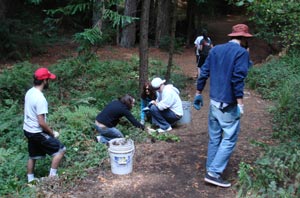On an overcast day in November, a group of people gathered at Long Marine Laboratory to get a little work done.
But these weren't marine biologists studying sea life. They were volunteers for Grounds Services' Site Stewardship program, and they were keeping their feet planted firmly on land. Their purpose: to dig out invasive plants from an earthen berm at the location and restore native species.
The program, started in 1995, consists of two university staffers who devote part of their hours to it, a few student interns and "a lot of volunteers," said Dave Roe, assistant superintendent of grounds. Roe spends about 20 percent of his time at work with Site Stewardship.
| Careful and deliberate stewardship of the magnificent UC Santa Cruz campus for more than four decades has ensured that the natural environment is maintained alongside world-class facilities for teaching and research. Read more |
"We take on ecological restoration and guardianship of campus land," said Roe.
That includes Long Marine Lab and areas surrounding university offices at 2300 Delaware Ave., in addition to the 2,000-acre campus, according to Dean Raven, senior superintendent at Physical Plant.
The program's projects have been aimed at mitigating and restoring some of the degraded natural areas affected by campus activities, said Roe.
For example, students searching for a shortcut from College Nine's Namaste Lounge to Bay Tree Plaza have carved out an ad hoc pathway through Jordan Gulch, trampling the vegetation and causing erosion, said Roe.
Site Stewardship has restored the trail, but they're trying to eliminate it as a trail altogether, because, said Roe, "if we ever get any rains it creates a lot of sediment runoff, and with the Clean Water Act, we're very concerned with maintaining proper storm water management practices. Which, for us, means no erosion."
They've fenced the trail off and posted signs saying students should take the paved road that goes up to College 9 and Social Science 1. As a way to make staying on walkways easier, they're looking into an additional crosswalk so students don't have to walk down to Chinquapin Road.
"We keep the students in mind as to why they're doing it and try to help them," said Roe.
Similarly, in Cowell Meadow above East Field, lots of ad hoc pathways developed as a result of Stevenson infill being built up, according to Roe. This was causing erosion. So, "last year we put in temporary fencing and signage and restored paths with different erosion-control techniques," he said.
They left some paths with erosive-deterrent armoring such as mulch, fiber roles, and jute netting so students could use some parts of the original paths, said Roe.
Much of the on-site work is coordinated by Bill Reid, Site Stewardship coordinator, who spends half his hours on the program and the other half working with grounds maintenance. This quarter, the program had four interns who worked with Reid weekly on projects including data collection, research, mapping, propagating native plants in campus greenhouses, weeding, planting, and outreach to other students.
Restoration projects are ongoing at the upper Jordan Gulch trail between the fire station and Social Sciences to reduce potential for erosion and at Long Marine Lab earthen berm, where exotic, invasive weeds are being replaced with some colorful native coastal species. The group also does meadow monitoring to measure vegetation growth and remaining thatch to provide data for managing the cattle grazing rotations and grassland mowing for fire control purposes.
The program also partners with the Campus Natural Reserve to coordinate volunteer work days, including areas on upper campus in the Natural Reserve and at Younger Lagoon next to Long Marine Lab.
The Site Stewardship program was started by Dean Fitch, now senior planner with Physical Planning and Construction. It was patterned after the management plan used by the Golden Gate National Recreation Area, which hugs the California coastline for nearly 60 miles in and around San Francisco and is one of the world's largest urban national parks. The GGNRA's stewardship incorporates community volunteerism and internships.
"There's never enough funding, including at Golden Gate, to take care of all the land, so one of the responses from management is to involve the community," said Raven.
Site Stewardship typically gets about 15 volunteers at the two or three work days it holds per quarter, said Roe. Most volunteers are students, but staff, faculty, and community members also have pitched in.
"A key component to the program's success is outreach to the campus community," said Roe.
Going forward, plans are to continue with the ongoing projects and step up invasive weed control this winter, said Roe.
"We see a lot of areas [in need of weed control], so much it's overwhelming," he said.
The first volunteer day next quarter will be Saturday, Jan. 26. The next two are joint work days with the Campus Natural Reserve on Sunday, Feb. 3, and Saturday, March 1.
For information about the program or to volunteer, call (831) 459-2643 or send an e-mail.



